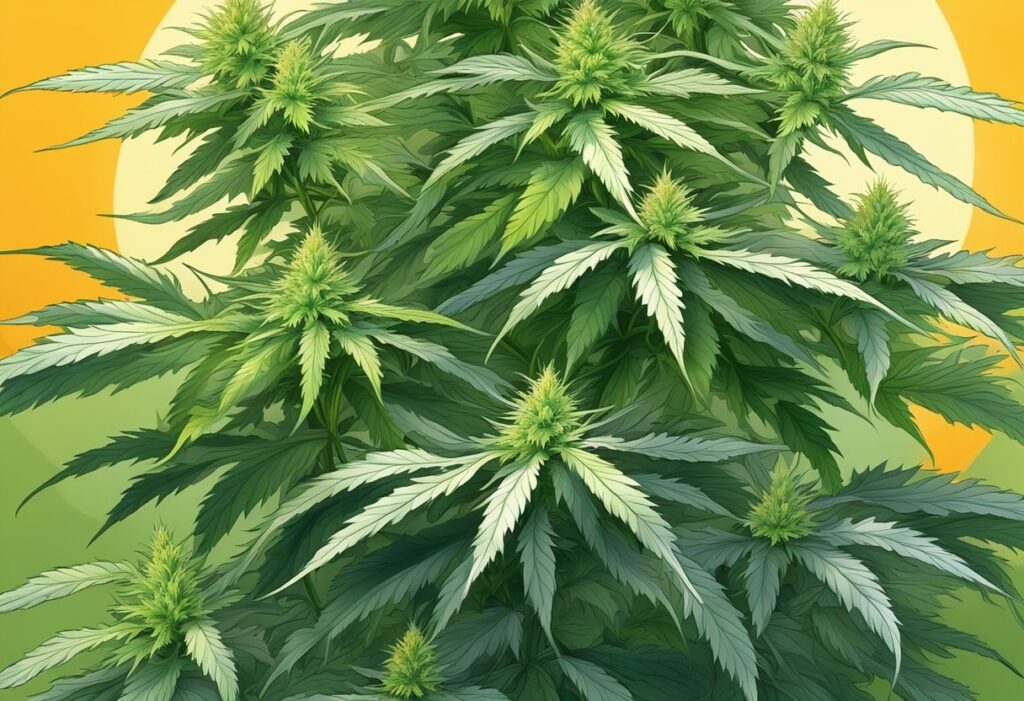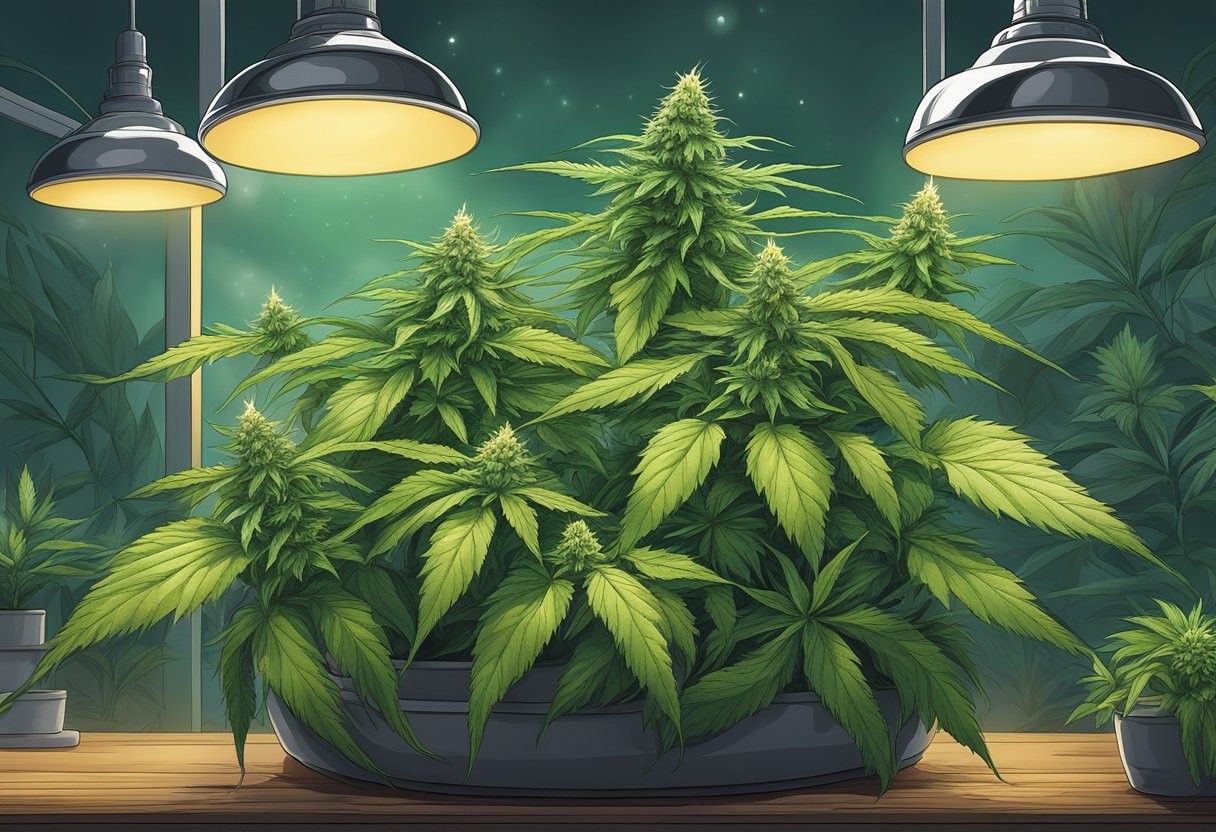
White Widow is a classic hybrid strain that offers a balanced experience, with genetics rooted in South Indian indica and Brazilian sativa. It is renowned for its potency and distinct profile of cannabinoids, predominantly THC.
White Widow is a hybrid cannabis strain with a balance of 50% indica and 40% sativa characteristics, the remaining 10% often attributed to the ruderalis variety, which contributes to its autoflowering capabilities. This blend provides a harmonious effect that delivers both relaxing and euphoric sensations, catering suitably to a varied audience.
This renowned strain is the progeny of two potent parents:
Together, these genetics create a versatile and robust plant that’s relatively easy to cultivate, thriving in a variety of growing conditions—an ideal choice for both novice and expert growers.
When understanding White Widow’s effects, it’s essential to consider the characteristics of its indica and sativa heritage:
By striking a balance between these effects, White Widow manages to be a strain that suits various occasions and preferences.
With a THC content that often reaches up to 20%, White Widow is quite potent and can deliver strong psychoactive effects. The CBD content, on the other hand, is typically low, generally falling below 1%. This high THC to low CBD ratio is what contributes to the strain’s intense cerebral high paired with noticeable bodily relaxation.
This cannabinoid profile makes White Widow a prevalent choice for recreational use while also providing possible therapeutic benefits, such as stress relief and pain reduction, associated with high-THC strains.

Successfully cultivating White Widow begins with a solid understanding of each stage, from selecting premium genetics to mastering the growth cycles. This guide equips you with expert tips to optimize your White Widow grow operation.
When selecting White Widow seeds, opt for reputable seed banks to ensure strong genetics. Germination is pivotal — consider the paper towel method for optimal results. Maintain a humidity level of 60-70% and avoid soaking the seeds to encourage successful sprouting.
Your choice between growing White Widow indoors or outdoors hinges on climate and space. Indoor environments allow for controlled conditions and a typical flowering time of 7-9 weeks. Outdoor growers should plan for a harvest by late October, with climate factors being more variable.
White Widow thrives in a climate with temperatures around 75-80°F (24-27°C). Whether indoors or outdoors, maintaining moderate humidity and shielding your plants from extreme weather is crucial for healthy development.
Decide between a soil setup or a hydroponic system based on your resources and experience. Soil is more forgiving for beginners, while hydroponics can lead to faster growth rates. Always ensure your medium is rich in nutrients suitable for the vegetative and flowering stages.
Regular watering is essential, though frequency varies based on the medium and plant size. Opt for a nutrient schedule that supports growth with increased phosphorus during the flowering stage. Careful monitoring will prevent overfeeding and nutrient burn.
During the vegetative stage, your White Widow will need ample light and space to grow. Transition to the flowering stage by adjusting the light cycle to 12 hours on, 12 hours off. Check the color of the pistils to time the harvest—aim for at least 70% amber.
For maximizing yields, the SCROG method is recommended for White Widow. This technique involves weaving the branches through a horizontal screen, promoting even canopy growth and optimal light exposure. Trim unnecessary foliage to enhance air circulation and light penetration.

To cultivate White Widow successfully, focus on creating an ideal microclimate that caters specifically to the strain’s needs. Precision in monitoring and adjusting pH levels, humidity, light cycles, and temperature—the cornerstones of cannabis cultivation—cannot be overstated.
Your White Widow’s root health hinges on maintaining the right pH levels. Aim for a pH between 6.0 to 6.5 for soil and 5.5 to 6.0 for hydroponic systems. Regularly test the pH and adjust with pH up or down solutions to prevent nutrient lockout.
Proper humidity is crucial for White Widow. During the vegetative stage, keep humidity at 55-70%. As you transition to flowering, gradually reduce to 40-50% to decrease the risk of mold and encourage resin production.
Light schedules must be strictly adhered to. Provide White Widow with 18-24 hours of light during the vegetative phase and shift to 12 hours on/12 hours off during flowering to stimulate bloom.
Maintain daytime temperatures between 70-85°F and slightly cooler at night, around 65-70°F. Your ventilation system should ensure consistent air exchange to keep the temperature stable and replenish CO2.
Mastering the harvesting and curing process is crucial for maximizing the potency and flavor of White Widow buds. These steps will guide you to ensuring the highest quality of your harvest.
To achieve the best potency, you need to time the harvest of your White Widow buds accurately. Observe the trichomes with a magnifier—when they turn from clear to a milky white color, this is typically the prime time for harvesting. Approximately 60 to 70% milky trichomes often indicate peak THC levels, while further amber coloration suggests a higher CBD content and a more physical, calming effect.
After harvesting, trimming your buds is next. Here are two trimming methods:
The technique you choose will affect the flavor and overall smoothness of your White Widow buds.
Curing is essential for developing the full flavor profile of your White Widow strain. Here’s a basic curing process:
Cure your buds for at least two to four weeks. This process will help in enhancing the complexity of the flavors and ensuring a smoother smoke.
Cultivating White Widow successfully requires you to navigate through typical horticultural challenges. Let’s tackle common growing issues to ensure your White Widow thrives.
Pests and diseases can compromise the health of your White Widow plants. Regular inspection is key to early detection and control. If you encounter pests, consider using neem oil or insecticidal soap as organic solutions. For fungal infections, proper air circulation and humidity control are crucial. In indoor setups, utilize fans and dehumidifiers to manage the environment.
Nutrient management is a precise science when growing White Widow. Implement a balanced feeding schedule to avoid deficiencies and toxicities. Here’s a simple guideline for essential nutrients during key growth stages:
Maintain a pH level between 6.0 and 7.0 for optimal nutrient uptake, and adjust as needed with pH up or down solutions.
Stress factors such as improper pruning, light leaks, and extreme temperatures can lead to hermitization, where the plants develop both male and female flowers. Monitor your plants closely and ensure:
By adhering to these guidelines, your White Widow plants are more likely to remain healthy and produce the desired yields.
Discover the nuances of the White Widow cannabis strain through firsthand accounts. This section hones in on the personal experiences of users with White Widow, covering its unique high, flavor complexity, mood-enhancing qualities, and therapeutic potential, alongside possible side effects.
White Widow is renowned for producing a high that is both cerebral and physical. You might notice a sense of increased mental awareness, which could lend itself to heightened focus and creativity, while simultaneously feeling a gentle body relaxation. This balance makes it well-suited for both daytime and evening use.
Your experience with White Widow will also be defined by its flavor profile. The primary flavors you’re likely to discern will range from earthy and woody to hints of pine, with subtle variations influenced by the specific cultivation techniques used. This strain offers a rich olfactory and gustatory journey.
Many users report that White Widow elevates mood by inducing euphoria and prompting relaxation. This strain is often sought after for its ability to relieve stress, with effects that are both uplifting and soothing, allowing you to unwind without becoming overly sedated.
While White Widow has a reputation for its anti-inflammatory properties, helpful in managing body pain, it is also associated with potential therapeutic effects for mental health issues, such as alleviating symptoms of anxiety. However, it’s important to be aware of possible side effects, which can include dry eyes and, less commonly, heightened anxiety or paranoia in sensitive individuals. Moderation and context are key when gauging how White Widow will interact with your body and mind.
White Widow has cemented its place as a cornerstone in cannabis culture with its potent effects and distinct heritage. As you dive into the world of this iconic strain, you’ll understand why it maintains its legendary status.
White Widow originated from the Netherlands in the early 1990s, a creation born under the expertise of breeder Shantibaba at the Green House Seed Company. It is a hybrid that leverages a Brazilian Sativa landrace, delivering an uplifting and energetic experience. Quickly, it dominated Amsterdam’s coffee-house scene, gaining popularity for its impressive potency and robust genetics.
White Widow acted as a genetic cornerstone, influencing a myriad of newer strains. Its balanced genetics make it a preferred choice for crossbreeding, yielding strains that capture its energizing effects and resinous buds. Breeders have harnessed White Widow’s stable profile to develop novel strains that continue to fascinate and please both growers and users alike.
Among recreational users, White Widow is celebrated for its ability to elevate mood and alleviate stress. The strain’s euphoric high is suitable for a wide range of activities and social settings. For medical users, it has been identified to relieve symptoms of depression, chronic pain, and insomnia. This reputation is balanced by an awareness of potential side effects, such as dry mouth, anxiety, and paranoia, reminding you to consume responsibly.
When growing White Widow outdoors, select a spot with ample sunlight and protection from strong winds. Use well-draining soil enriched with organic nutrients. Maintain a consistent watering schedule and monitor for pests regularly.
To optimize flowering, ensure your White Widow plants receive 12 hours of uninterrupted darkness each night. Maintain appropriate humidity levels (around 40-50%) and temperatures (68-77°F, or 20-25°C) to support bud development. A lower night-time temperature can help enhance the trichome production towards the end of the flowering stage.
White Widow is known for its potent cerebral effects, providing an uplifting and euphoric sensation that can stimulate creativity and sociability. It also can offer a sense of relaxation without heavy sedation, making it suitable for daytime use.
Expect White Widow’s full growth cycle, from seed to harvest, to take approximately 8-9 weeks for the flowering stage after the vegetative phase, which can last around 4-8 weeks. This timeline can vary slightly based on environmental conditions and growing techniques.
To maximize your yield outdoors, implement training techniques like Low Stress Training (LST) or Screen of Green (ScrOG) to encourage wider growth and more bud sites. Ensure proper nutrient management, especially during the flowering phase, to support bud density and size.
We ship and deliver world wide via USPS and various couriers.
We offer a wide range of secure and anonymous online payment options.
We care about you, our customer. Please contact us with any questions or concerns.
Find out more about the benefits of being a loyal and regular customer.
WE ARE EVERY GROWERS ONE STOP SHOP TO ACQUIRE PREMIUM CANNABIS SEEDS FOR SALE IN THE USA, CANADA AND AUSTRALIA

Farmers Lab Seeds 2024, | All Right Reserved
Seeds are sold as novelty items, souvenirs, and collectibles. They contain 0% THC. We encourage our customers to check the legislation in their Country, State, Province, and Municipality prior to purchasing items from our store. We do not provide growing information.
All seeds are sold as hemp, and lab tested under 0.3% THC. This product is not for use by or sale to persons under the age of 21. This product should be used only as directed on the label. It should not be used if you are pregnant or nursing. Consult with a physician before use if you have a serious medical condition or use prescription medications. A Doctor’s advice should be sought before using this and any supplemental dietary product. All trademarks and copyrights are property of their respective owners and are not affiliated with nor do they endorse this product.
These statements have not been evaluated by the FDA. This product is not intended to diagnose, treat, cure or prevent any disease. Individual weight loss results will vary. By using this site, you agree to follow the Privacy Policy and all Terms & Conditions printed on this site. Void Where Prohibited by Law.